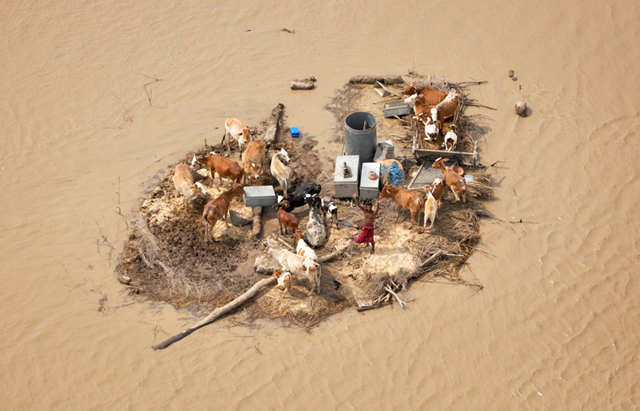UN: Pakistan flood impact assessment, September 2010 — ‘Evolving crisis on an unprecedented scale’
Full Report [pdf – 3.8 Mbytes] United Nations World Food Programme (WFP)
Date: 22 Sep 2010 EXECUTIVE SUMMARY The monsoon induced flooding in Pakistan constitutes an evolving crisis on an unprecedented scale. The impact of the flood has varied: The flash floods in the mountainous north (KPK) were intense and highly destructive. This was also largely the case in parts of Balochistan. In flatter areas of Punjab and northern Sindh, riverine flooding has been a very destructive phenomenon, although with a slower onset, affecting densely populated and cultivated areas. In lower Sindh, the ongoing riverine delta flooding may have longer lasting effects due to soil saturation of these low lying areas. To date, this assessment identified at least 14.1 million people who were directly affected by the flood across Pakistan. Other estimates may be higher and include indirectly affected populations. More than 1.1 million houses were completely destroyed or made unliveable and more than 2 million hectares of standing crops were damaged or lost. The people most severely affected were predominantly small farmers and unskilled labourers. They are among the most vulnerable in Pakistan and almost all live below or just above the national poverty line. More than 60 percent lost immediate access to their primary livelihood and are faced with a drop in their already low income by more than half. The significant increase in food prices in flood affected areas is exacerbating the situation. More than three quarters of the affected population have access to less than one week supply of food. Livestock was severely impacted with on average 40% of livestock lost by flood affected households. Almost half of the affected population have unacceptable food intake, in spite of the efforts by government/army, NGOs, UN and the general public. Nutrition measurements indicate that the malnutrition situation is deteriorating. Based on the number of destroyed and unliveable houses as well as the extent of crop losses, 10.1 million people are in need of immediate assistance. Within this group, considering current food consumption levels and displacement status, at least 7.8 million are particularly vulnerable to lasting food insecurity. Longer term food assistance requirements for recovery and rehabilitation programmes amount to 3.6 million people living in highly food insecure area.
Pakistan flood impact assessment, September 2010 
By Katherine Tiedemann
Wednesday, September 22, 2010 – 8:24 AM At least two suspected U.S. drone strikes hit targets in South Waziristan yesterday, killing a handful of alleged militants and marking the 70th and 71st such reported strikes this year (AFP, Reuters, CNN, AJE). The strikes reportedly targeted fighters of Mullah Nazir, a local Taliban commander (BBC). Pakistani security forces are carrying out operations against local militants engaged in kidnappings for ransom and attacks on peace committee members in the semi-tribal area of Frontier Region Peshawar, and 30 have reportedly been killed since Saturday (Dawn, ET).

These comments are absolutely nothing to do with your article, I just wanted to tell, that I feel honored whenever I am visiting your blog's. but at least these reasons can be make growing the flowers of silaturakhim in our life and our dreams. I've become your follower. When you did not mind, so good follow behind me also.Thank you